Dredmor reviving back up somehow isn't the only surprise after more than a decade:
https://roguebasin.com/index.php/Triangle_Wizard_2
https://roguebasin.com/index.php/Triangle_Wizard_2
What?Dredmor reviving back up
As per a few posts back, Dredmor is getting some kind of new development after all these years as they lost all their old mailing lists upon getting things going anew(there was a pop up on their old website, then people started digging on the Steam community page, then the twitter account came alive again, etc)---nobody knows if it'll be a new expansion or something else entirely, nor who all is on the team beyond nvining given pretty well everybody scattered to the winds after CE.What?Dredmor reviving back up

Greetings Wizards. Been a while, hasn't it?
A while ago I decided to stop updating Rift Wizard 1 to devote my full energies to Rift Wizard 2.
I did this because I wanted to try some things that would be
wildly
inappropriate for a patch- things that, in my opinion, have the potential to improve the game quite a bit.
RW2 started as a direct fork of RW1, but unlike in a patch, I had absolute creative freedom to go in any direction I pleased. I tried quite a few things. Some worked, some didn't. Those that worked, well, they are Rift Wizard 2. Its been a blast, and its nearly time to start sharing it with a wider audience.
The most significant new feature in Rift Wizard 2 is equipment. Random drops are a part of most roguelikes. Rift Wizard 1 plays around a bit with random drops in the form of shrines, but mostly emphasizes the non-random SP buyable skills, spells and upgrades. Rift Wizard 2 replaces shrines with equipment. You can hold a staff, wear a robe a hat and boots, and have any number of miscellaneous trinkets active. One article of equipment tends to be less powerful than a shrine, but applies to more than one spell, and can stack with other equipment.
Its much easier to design equipment than it is to design shrines, and thus, RW2 already has more equipment than RW1 had shrines. Equipment adds a flavor of chaos and randomness to the game that RW1 lacked, and gives each run a sense of uniqueness and gravity- permadeath + random drops is a powerful combination.
RW2 also contains many
large
balance changes. Potions are reduced in quantity, but a free refill is given at the end of each level. Spells can be upgraded only once (though generally with more powerful individual upgrades than they had in RW1). Realms 1-5 only grant 2SP, with realms 10+ granting 4+. Damage redeals no longer bypass resistances. Levels are bigger (well actually, the levels now scale with your monitor resolution, but the main supported size is bigger- 33x33 instead of 28x28). The game ends at level 21 instead of level 25.
One big balance goal of RW2 was to reduce the incentives pushing the player towards picking one 'carry' spell and ignoring everything else. I think the most fun situations in RW are the ones where the player has many viable choices about what to do with their turn, and this is much more common in runs where the player has 5-10 spells than 1-3.
Rift Wizard 2 also contains many new challenges to face. The old hand crafted variant system is replaced with a procedural one, many new enemy wizards are added, and the monster list is in the process of being revised.
Ultimately, Rift Wizard 2 is quite similar in many ways to Rift Wizard 1. Yet it is also quite different. Rift Wizard 2 embraces randomness to a degree that Rift Wizard 1 did not. It has higher variance between runs, meaning winning once is probably easier, but streaking is probably harder. Following guides and forcing builds is much, much harder. But the fundamental game is the same: spend SP to upgrade your wizard and guide said wizard turn by turn through a series of randomly generated levels.
Rift Wizard 2 will enter early access in January, which I expect to last a year, mostly devoted to content creation and balance.
Check out the screenshots and trailer (and follow/wishlist the game!) here.
A sequel to Rift Wizard (a very neat little coffebreak roguelike based around building spells, essentially) was announced yesterday, due to launch in Early Access around January:
Greetings Wizards. Been a while, hasn't it?
A while ago I decided to stop updating Rift Wizard 1 to devote my full energies to Rift Wizard 2.
I did this because I wanted to try some things that would be
wildly
inappropriate for a patch- things that, in my opinion, have the potential to improve the game quite a bit.
RW2 started as a direct fork of RW1, but unlike in a patch, I had absolute creative freedom to go in any direction I pleased. I tried quite a few things. Some worked, some didn't. Those that worked, well, they are Rift Wizard 2. Its been a blast, and its nearly time to start sharing it with a wider audience.
The most significant new feature in Rift Wizard 2 is equipment. Random drops are a part of most roguelikes. Rift Wizard 1 plays around a bit with random drops in the form of shrines, but mostly emphasizes the non-random SP buyable skills, spells and upgrades. Rift Wizard 2 replaces shrines with equipment. You can hold a staff, wear a robe a hat and boots, and have any number of miscellaneous trinkets active. One article of equipment tends to be less powerful than a shrine, but applies to more than one spell, and can stack with other equipment.
Its much easier to design equipment than it is to design shrines, and thus, RW2 already has more equipment than RW1 had shrines. Equipment adds a flavor of chaos and randomness to the game that RW1 lacked, and gives each run a sense of uniqueness and gravity- permadeath + random drops is a powerful combination.
RW2 also contains many
large
balance changes. Potions are reduced in quantity, but a free refill is given at the end of each level. Spells can be upgraded only once (though generally with more powerful individual upgrades than they had in RW1). Realms 1-5 only grant 2SP, with realms 10+ granting 4+. Damage redeals no longer bypass resistances. Levels are bigger (well actually, the levels now scale with your monitor resolution, but the main supported size is bigger- 33x33 instead of 28x28). The game ends at level 21 instead of level 25.
One big balance goal of RW2 was to reduce the incentives pushing the player towards picking one 'carry' spell and ignoring everything else. I think the most fun situations in RW are the ones where the player has many viable choices about what to do with their turn, and this is much more common in runs where the player has 5-10 spells than 1-3.
Rift Wizard 2 also contains many new challenges to face. The old hand crafted variant system is replaced with a procedural one, many new enemy wizards are added, and the monster list is in the process of being revised.
Ultimately, Rift Wizard 2 is quite similar in many ways to Rift Wizard 1. Yet it is also quite different. Rift Wizard 2 embraces randomness to a degree that Rift Wizard 1 did not. It has higher variance between runs, meaning winning once is probably easier, but streaking is probably harder. Following guides and forcing builds is much, much harder. But the fundamental game is the same: spend SP to upgrade your wizard and guide said wizard turn by turn through a series of randomly generated levels.
Rift Wizard 2 will enter early access in January, which I expect to last a year, mostly devoted to content creation and balance.
Check out the screenshots and trailer (and follow/wishlist the game!) here.
Eh, the shrines enabled enough stuff that it was fairly high variability anyways. Not to mention being forced to take specific spells to handle whatever random levels got handed to you; sometimes you have to abandon that tried and true build for a few floors because everything is immune to lightning for whatever reason. At least, that was my experience playing through the challenge modes. I suppose on the default setting the game is generally easy enough to allow doing the same shit every time, provided that shit has enough wiggle room. Anyways, looking forward to it, Rift Wizard is a ton of fun.Wasn't low-variability build tinkering the forte of Rift Wizard. Rando runs is every other roguelike/lite.

Stop playing past the point where you become a walking god of postapocalypse and start a new game. Only early and sometimes mid game pose any challenge in Cataclysm anyway. That's the only help i can provide.Is there a way to reduce the size of CDDA save files?
Some people play with them enabled. They're usually free meat and items when you get strong enough to deal with them.- I see that in BN the option "random NPC" is set to false by default and there aren't any sub-options - like how often random NPCs should spawn. I clearly remember that, at some point, you could set up how often random NPCs appear in DDA. I remember using them - but only with a very low chance of appearing, this way there was, very rarely, chance for surprise to be had but no big change for how the game played. Do people play with them nowadays at all?

- How are zombie hordes (wander spawns) work nowadays? Has been any changes done in DDA or BN in the past few years? Do you play with them on?
I see that in BN the option "random NPC" is set to false by default and there aren't any sub-options - like how often random NPCs should spawn. I clearly remember that, at some point, you could set up how often random NPCs appear in DDA. I remember using them - but only with a very low chance of appearing, this way there was, very rarely, chance for surprise to be had but no big change for how the game played. Do people play with them nowadays at all?

I find labelling traits you take during character creation as "mutations" a little out of place. They should be called "traits", since there are specific things you need to do in-game to get mutations after character creation, like getting exposed to radiation or taking mutagens.Anyone noticed in Cataclysm (BN) when you take "Quick" trait that gives you 10% speed bonus. It later shows on your character sheet (@) as "mutation + 10%". In DDA it always showed simply as "Quick + 10%". No practical difference i suppose. I don't know why but it bothers me. Probably some compulsion of mine.
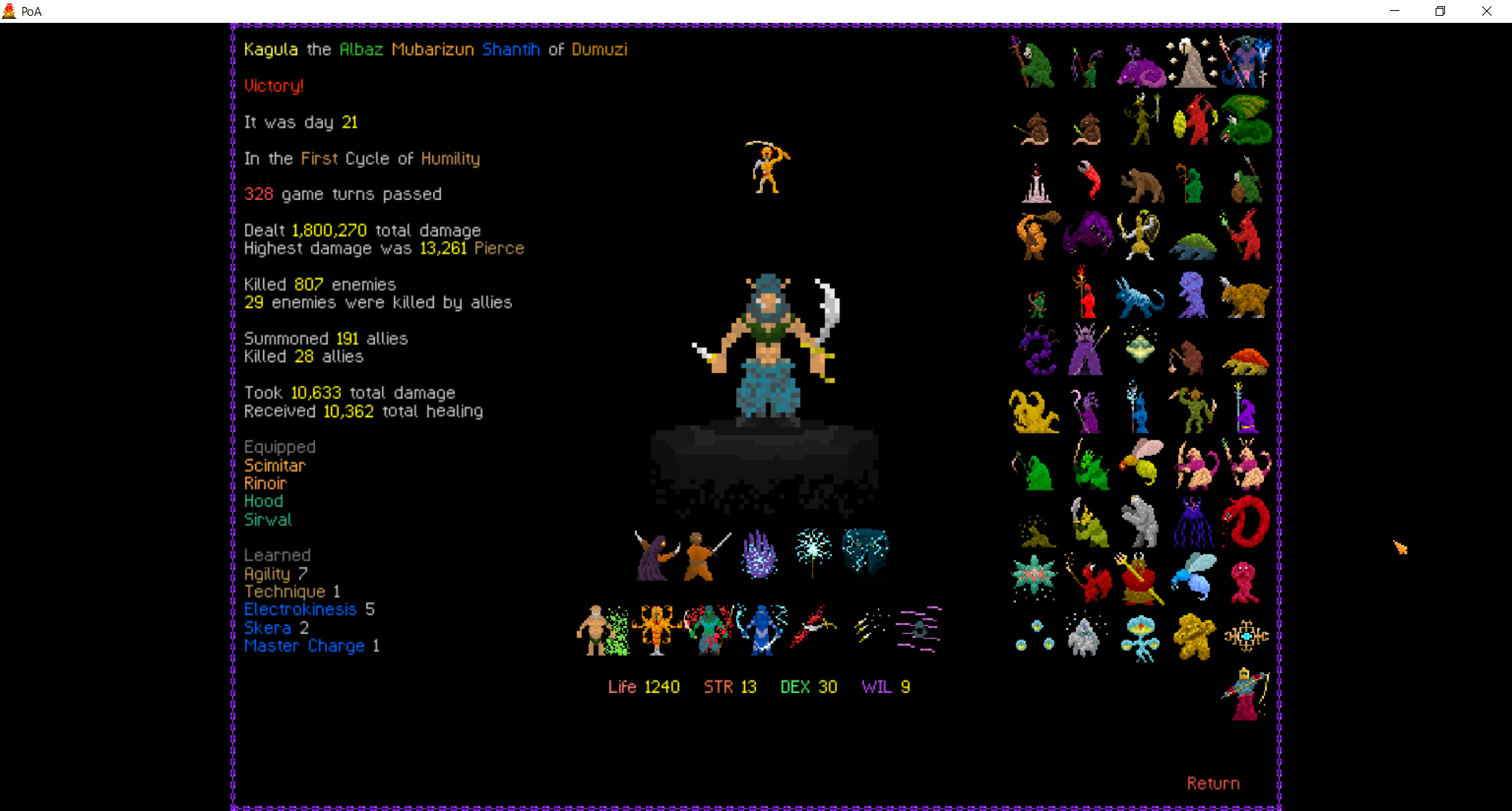
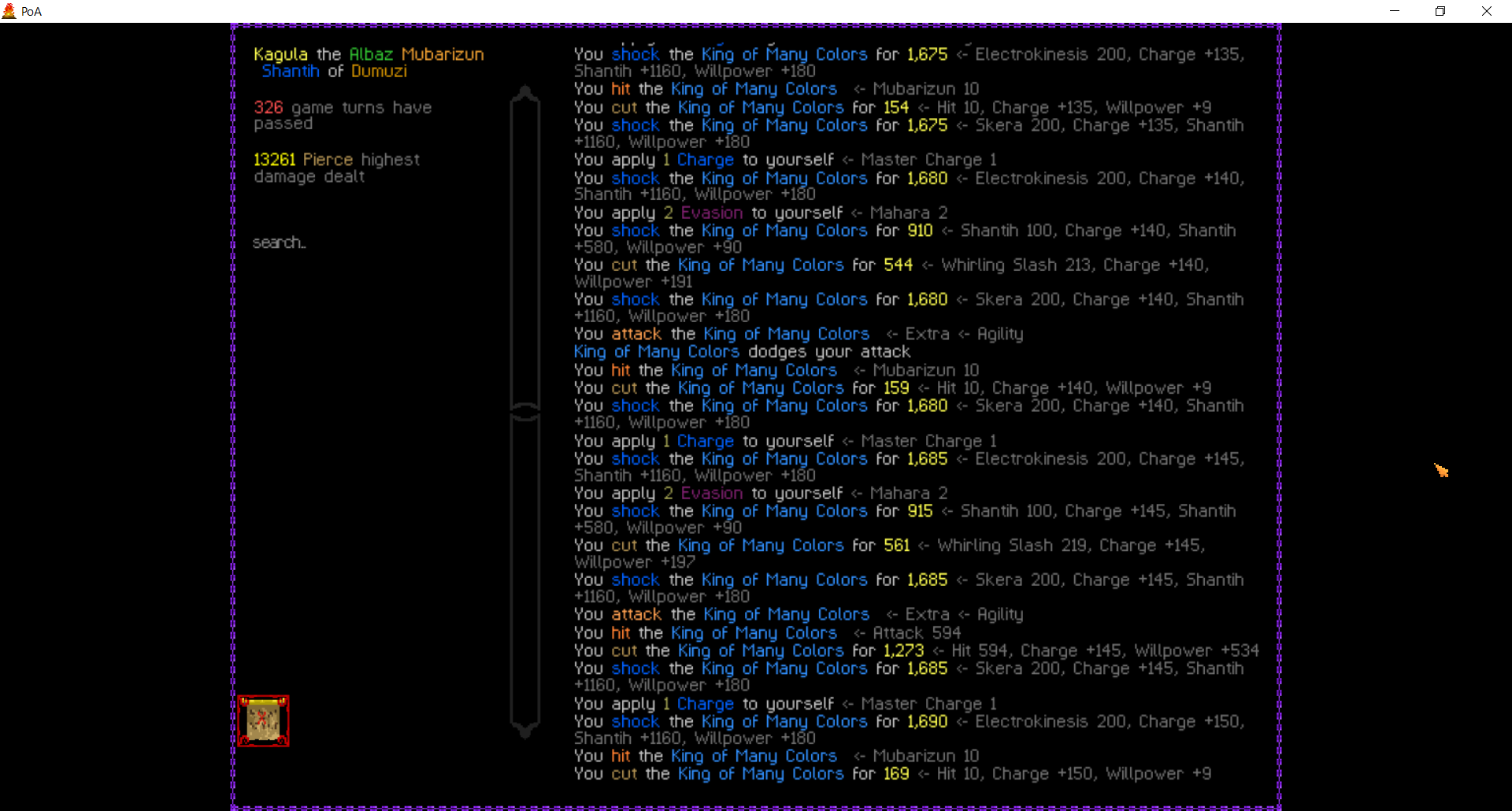
they want money for this?I've been enjoying Path of Achra for quite a bit. It satisfies my specific desire for some buildporn.

Dumuzi who gifts you with heavy armors and prayers that scale with armor rating was actually a very terrible choice of god for my lightning bladedancer character who deals damage by being constantly on the move.
Still managed to pull a win.
It appears the difficulty of the world is gradually increasing as you're accumulating wins. Next run promises to be more challenging.
You get plenty of abilities and elements to choose from in order to build your character. The only directly toggleable ones you have are the three prayers from your chosen god, the rest of them are passives of sorts that are triggered by certain actions like "deal fire damage on attack/hit", "upon applying fire damage heal yourself and apply scorch", "upon standing still teleport to a nearest enemy and blast everything with astral damage" or my favourite "upon entering a level summon a thing"does it do anything interesting?
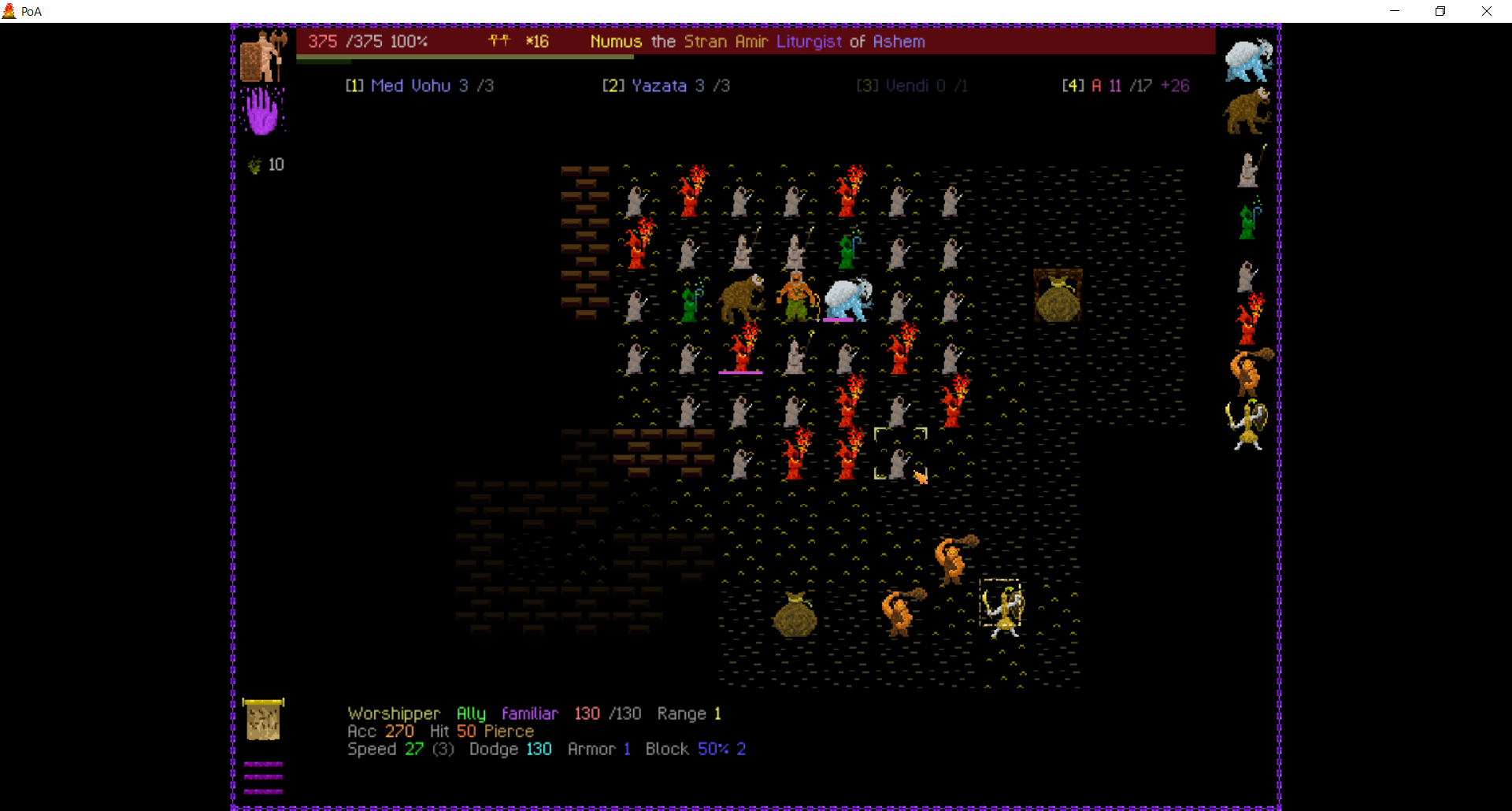
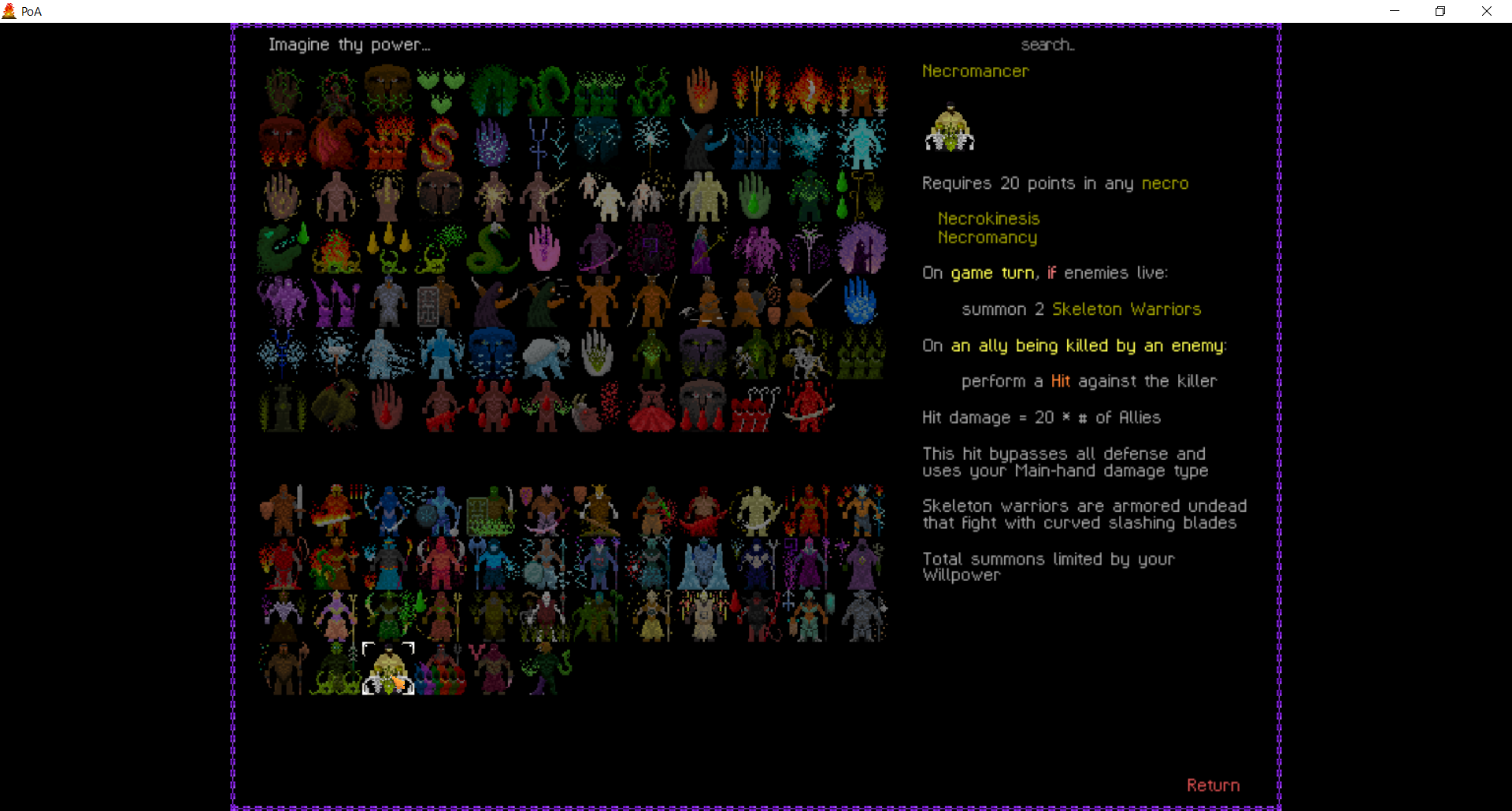
The fact that everything is a passive is retarded. I presume playing a spellcaster is like a turn based Vampire Survivors.The only directly toggleable ones you have are the three prayers from your chosen god, the rest of them are passives
This is how I felt while playing the game. Also the game can play itself way too often if you put it on auto-explore or whatever it's called in-game.The fact that everything is a passive is retarded.
What's so enjoyable about auto-explore that it's worth making it a design goal for a game?I feel I must self-promote here, as my design goal for Path of Achra was to emphasize the fluidity of DCSS "o-tabbing" (auto attack / explore) and the build-making of Rift Wizard. Runs last around 10-60 minutes. The Steam demo is the full game. It's also free to play on itch / in browser
The same appeal as ARPG genre i think.What's so enjoyable about auto-explore that it's worth making it a design goal for a game?
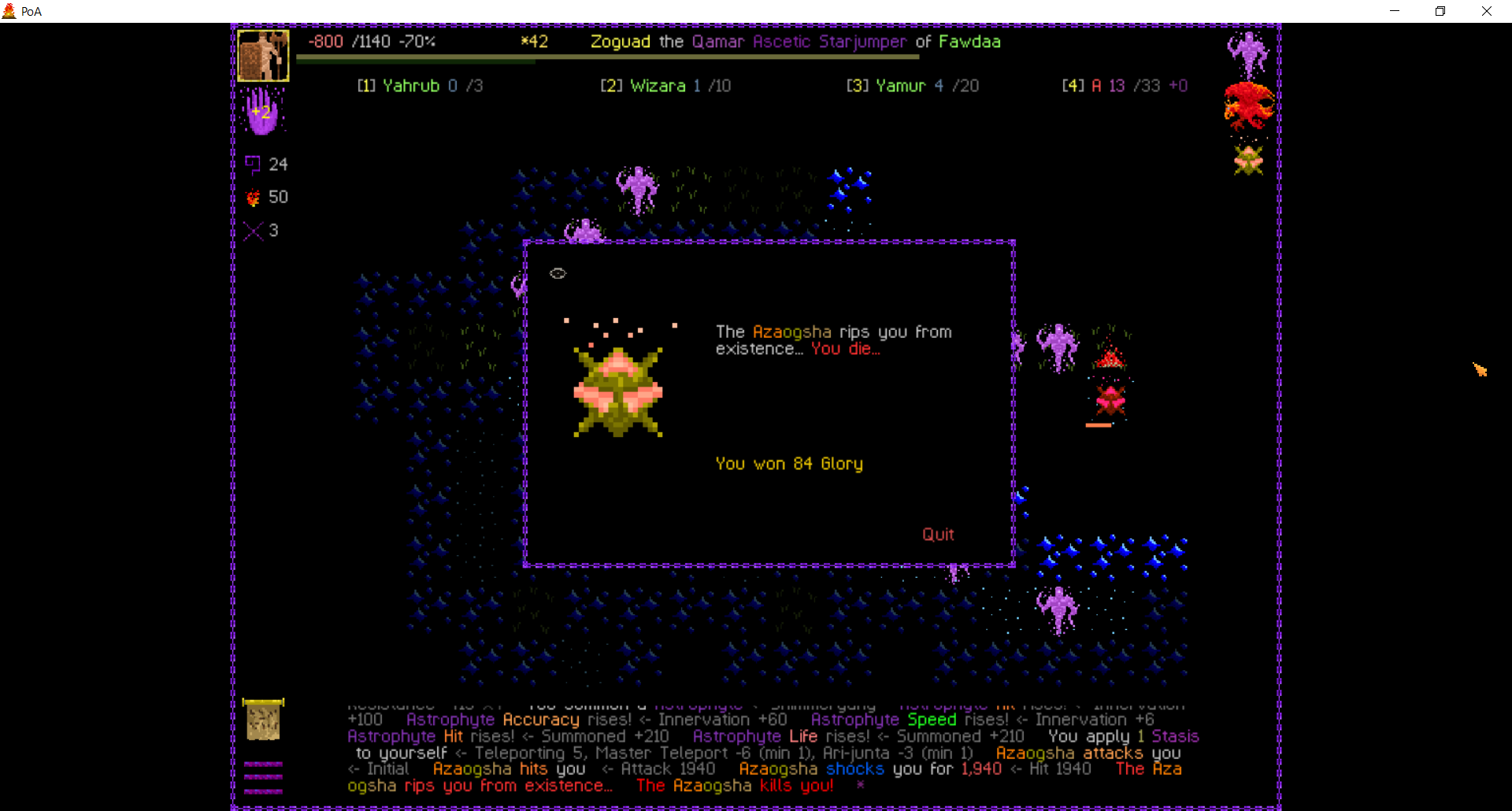
 I was so close to the final boss, damn it! Couldn't even attempt to escape the level as each of my steps triggered a teleportation near this fella.
I was so close to the final boss, damn it! Couldn't even attempt to escape the level as each of my steps triggered a teleportation near this fella.






